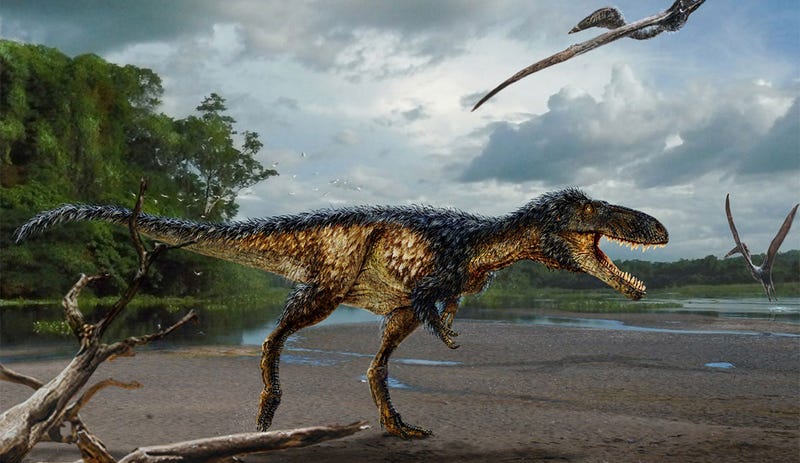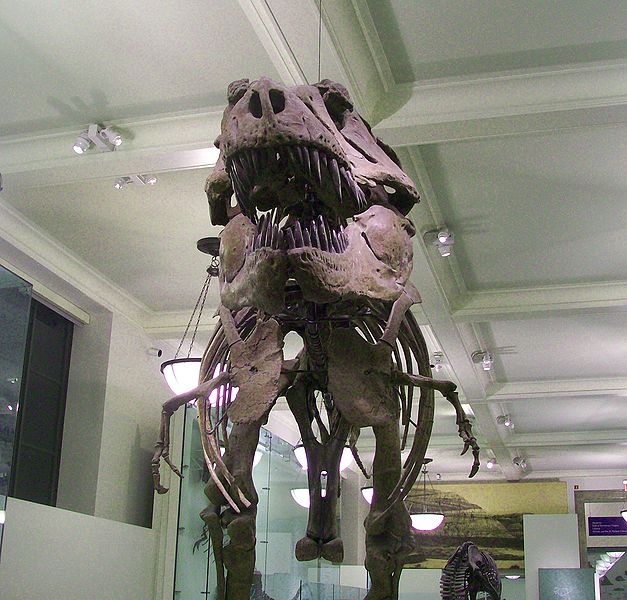Advertisement
If you have a new account but are having problems posting or verifying your account, please email us on hello@boards.ie for help. Thanks :)
Hello all! Please ensure that you are posting a new thread or question in the appropriate forum. The Feedback forum is overwhelmed with questions that are having to be moved elsewhere. If you need help to verify your account contact hello@boards.ie
Timurlengia, new "missing link" tyrannosaur
Options
-
15-03-2016 7:47pm#1
Comments
-
Now this is a very interesting find. A lightweight, relatively small yet well-developed tyrranosaurid, brainy for its kind, certainly a skilled hunter without the huge proportions of T-Rex himself. Which goes to show that brawn is not everything. The raptors are living (sorry, dead
 ) proof of that. Timurlengia had obviously retained the streamlined lithe body of his ancestors without sacrificing efficiency or strength in capturing prey. It would be interesting to find out how long this new species lasted on the Earth. Although Timurlengia is a kind of missing link, we have yet to discover the series of progressively larger tyrannosaurids which led up to T-Rex. 0
) proof of that. Timurlengia had obviously retained the streamlined lithe body of his ancestors without sacrificing efficiency or strength in capturing prey. It would be interesting to find out how long this new species lasted on the Earth. Although Timurlengia is a kind of missing link, we have yet to discover the series of progressively larger tyrannosaurids which led up to T-Rex. 0 -
I don´t think we can say if it had T. rex proportions... from what I've seen the remains are really fragmentary, with most of the skeleton still unknown.
According to Nat Geo,"In the meantime (until new remains are found), all paleontologists knows for sure is that Timurlengia [was no sensory slouch"
I suspect many dinosaurs known from fragments may end up being much more bizarre than we imagine. Consider Deinocheirus, for example.Although Timurlengia is a kind of missing link, we have yet to discover the series of progressively larger tyrannosaurids which led up to T-Rex.
Actually the sequence is pretty clear by now, with an obvious tendency towards gigantism ever since the beginning of tyrannosauroid history. By the time tyrannosaurids proper evolved, they were already pretty large animals. Check it out:
Proceratosaurus (165 million years ago, only skull known- estimated to have been around 3 meters long)
Guanlong (160 million years ago, pretty decent remains known, around 3 meters long)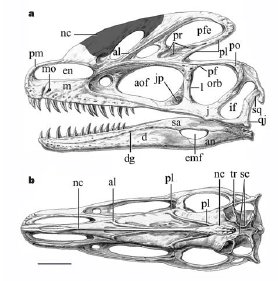
Tanycolagreus (150 million years ago, pretty decent remains known, tentatively classified as a tyrannosauroid, probably over 4 meters)
Eotyrannus (130 million years ago, fragmentary remains known, juvenile is 4 meters long so adult may have been somewhat bigger)*
Dilong (125 million years ago, great remains known, over 2 meters long)
Yutyrannus (125 million years ago, great remains known, apparently a giant proceratosaurid, up to 9 meters long. Note that it coexisted with Dilong at the same time so there were small and large species evolving together and occupying different niches)
Sinotyrannus (120 million years ago, fragmentary remains known, apparently a giant proceratosaurid (descended from Dilong?) estimated to be 9-10 meters long)
Note that these giant proceratosaurids were already as big as most late tyrannosaurids, but appear to have died out at this point. The later tyrannosauroids probably stem from smaller forms.
Xiongguanlong (112 million years ago, partial remains known, 4-5 meters, more similar to late tyrannosaurs. Remains of similar animal known also from North America)
Timurlengia fits this gap (90 million years ago, remains very fragmentary, size unknown, estimate 3-4 meters)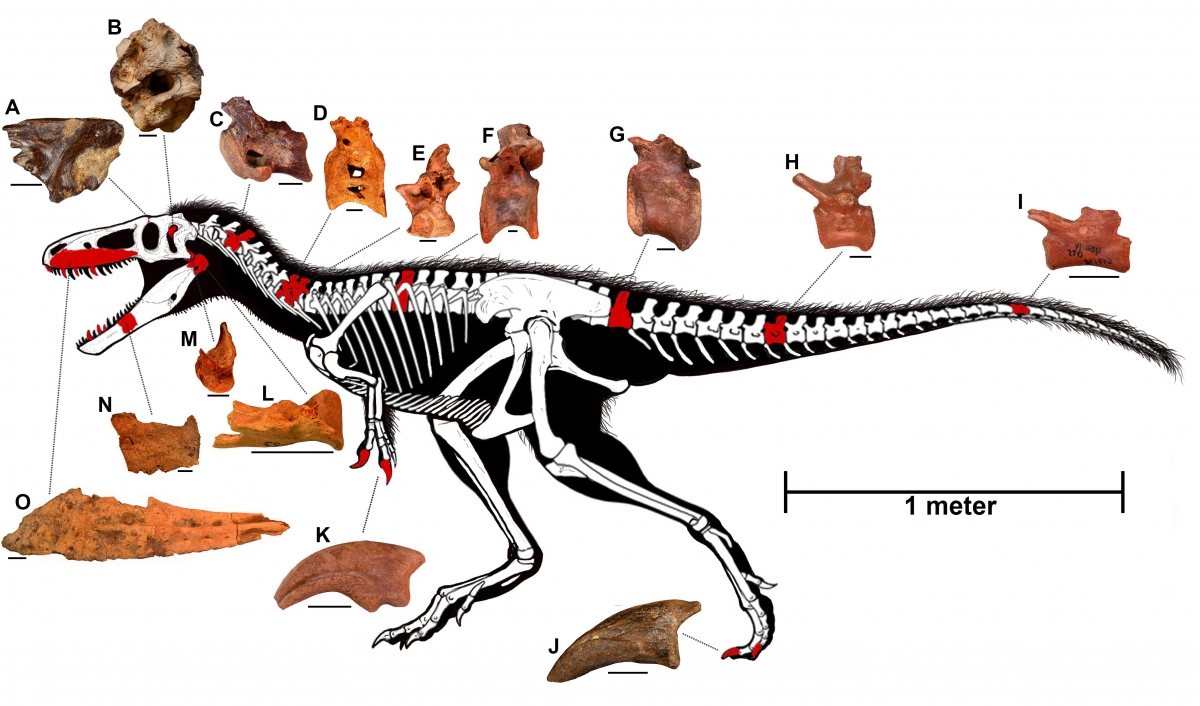
Alectrosaurus (84 million years ago, remains fragmentary but apparently new ones have been found and are currently being studied, estimated at 5 meters long, may have been larger)
After this you have tyrannosaurids proper (Tyrannosauridae), but by now they were already pretty large animals:
Lythronax (80 million years ago, 8 meters)
Appalachiosaurus (77 million years ago, partial remains, juvenile was 7 meters long so may have been quite bigger; once thought to have had long, three clawed arms; in truth, the arms are unknown. NOTE: this was a dryptosaurid, belonging to a separate family that lived at the same time as tyrannosaurids proper)
Bistahieversor (74 million years ago, 9 meters)
Gorgosaurus(76 ,million years ago, 9 meters long, probably the ancestor to Albertosaurus which seems to have reached 10 meters). Albertosaurines are a separate branch of the tyrannosaurid family- not T.rex ancestors)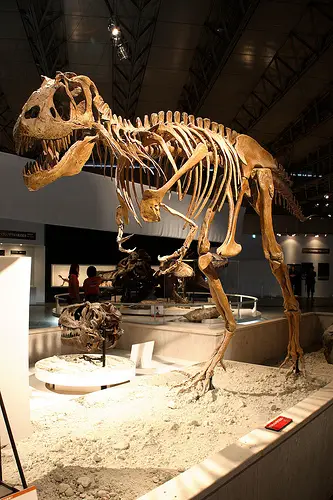
Daspletosaurus (74 million years ago, 9 meters. Traditionally assumed to have been Tyrannosaurus' ancestor, although not everyone is sure. T. rex may have been descended from Asian invaders (maybe something like Tarbosaurus). However, there is a fossil currently under study and informally known as "Alamotyrannus" that dates from 70 million years ago, and could conceivably be T. rex's ancestor, perhaps a transitional form between Daspletosaurus and Tyrannosaurus Apparently this "Alamotyrannus" is not fully grown so I can´t say anything about size. Said to be large, though).
Tarbosaurus (70 million years ago, up to 12 meters, may or may not be the ancestor to Tyrannosaurus rex, with some authors calling it Tyrannosaurus bataar, and others suggesting it may have been a giant descendant of the light-weight- although still large- alioramines, another side branch of the family)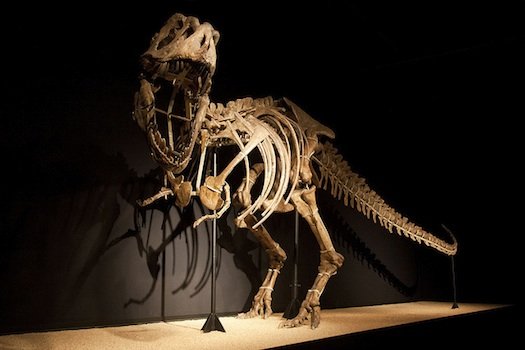
And finally 68-66 million years ago you have Tyrannosaurus rex which is the biggest (12-13 meters long).
*Eotyrannus is currently classified as a megaraptoran, and a skull of Megaraptor was recently found and turned out to be tyrannosauroid-like, meaning these may have been yet another branch of the same linneage. Megaraptorans apparently reached huge sizes as well, with Megaraptor being around 8-9 meters long, and fragmentary remains suggesting T. rex sized genera. This would mean that tyrannosauroids evolved giant size at least three times- once with proceratosaurids, once with megaraptorans, and once with tyrannosaurids.0
Advertisement
